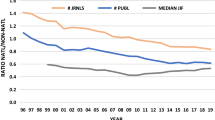Abstract
The aim of this study was to assess the influence of civil war during recent disintegration of the former Yugoslavia on scientific output, as measured by changes in numbers of articles published in peer-reviewed journals. The articles published in journals indexed in the Science Citation Index (SCI) were retrieved for the former Yugoslav republics. According to the census of 1991, the republics" populations were as follows: Serbia 9.7 million inhabitants, Croatia 4.7, Bosnia and Herzegovina (B&H) 4.3, Macedonia 2.0, Slovenia 1.9, and Montenegro 0.6. The annual numbers of articles from each were determined from 1988 to 2000. This period includes three prewar years, 5 years of civil war from 1991 to 1995, and the NATO military interventions in B&H (1995) and F.R. Yugoslavia (1999), which includes Serbia and Montenegro. In the late 1980s, Serbia produced more than 900 scientific articles per year and was well ahead, with twice as many publications as Slovenia. The number of publications from Croatia fell between that of Serbia and Slovenia. In the prewar period, the remaining republics had a relatively small scientific presence. The outputs from B&H decreased, from 50 articles in 1991, sharply during the war and continued to decrease. During the postwar period only 18 to 27 papers per year were published. In 1995, the output from Serbia dropped 33% in comparison to 1991. Slovenia produced more publications that year while Croatia was stagnant, and 3 most productive states had a similar output. In 1998, Serbia produced 1543 publications, Slovenia 1116, Croatia 1103, Macedonia 100, B&H 25, and Montenegro 12. The number of articles from Serbia dropped in 1999 and 2000 for 10.2% and 27.9%, respectively, in comparison to 1998. For the same two years, the number of publications was increased in Croatia (37.3% and 12,5%), Slovenia (10.9% and 52.8%), Macedonia (5% and 6%) and Montenegro (75% and 66%). The concentration of scientific research in well-established universities caused an uneven distribution of scientific output among various republics. Thus, the annual output of scientific papers per 100,000 inhabitants in 1990 greatly varied in various republics. In Montenegro it was 1.79, B&H 1.95, Macedonia 2,36, Serbia 11.92, Croatia 18.40 and Slovenia 29.63. In 2000, the annual output per 100,000 inhabitants in these republics was 3.41, 0.61, 5.24, 11,34, 26.00 and 76.84, respectively. The scientific production in B&H and in Serbia was affected not only by the devastated economy, damaged communications, and hardship of everyday life during the war and postwar years, but because many scientists left the country, and the scientists in Serbia were isolated from the international scientific community.
Similar content being viewed by others
References
Andri ć, I., The Bridge on the Drina University of Chicago Press, Chicago IL, 1977.
Jelavich, B., The Establishment of the Balkan National States, 1804-1920. University of Washington Press, Seattle WA, 1986.
Igi ć, R., Amid war, scientific publication survives in former Yugoslav republics, Scientist 11 (1997) 11.
Anonymous, Popis 1991. (The 1991 Census), Savezni zavod za statistiku, Beograd, Yugoslavia, 1997.
Lewison, G., Igić, R., Yugoslav politics, “ethnic cleansing” and co-authorship in science, Scientometrics 44 (1999) 183-192.
Stone, R., Yugoslavia: Science goes begging in recovery package, Science 293 (2001) 413b.
Salton, G., Automatic Text Processing Addison Wesley Publishing, 1989.
De Bruin, R. E., Braam, R. R., Moed, H. F., Bibliometric lines in the sand, Nature 349 (1991) 559-562.
Yusuf, S., Anand, S., Macqueen, G., Can medicine prevent war? Imaginative thinking shows that it might, British Medical Journal 317 (1998) 1669-1670.
Igi ć, R., Medicine can prevent war, Pakistan Armend Forces Medical Journal 49 (1999) 80.
Author information
Authors and Affiliations
Rights and permissions
About this article
Cite this article
Igić, R. The influence of the civil war in Yugoslavia on publishing in peer-reviewed journals. Scientometrics 53, 447–452 (2002). https://doi.org/10.1023/A:1014833315145
Issue Date:
DOI: https://doi.org/10.1023/A:1014833315145



